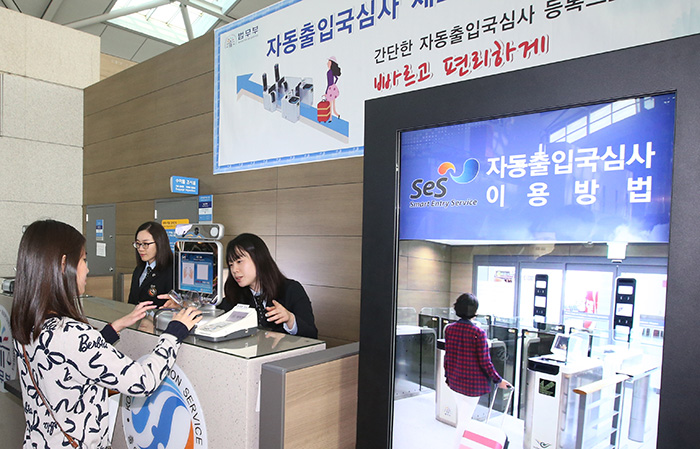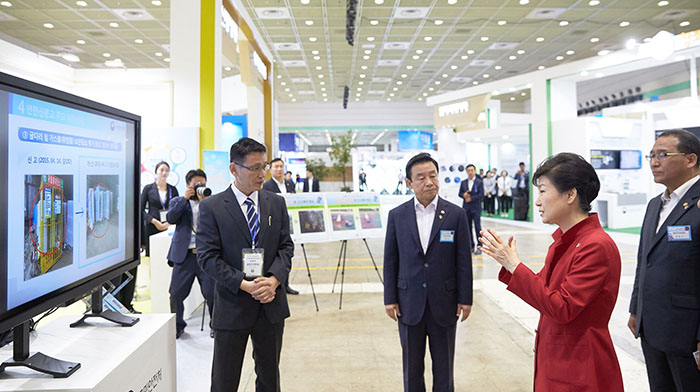| The Korean government has been concentrating on establishing e-government services since 1987 when it enacted laws expanding the supply of desktops and promoting the use of computer networks in order to provide high quality government service to its citizens in a more convenient manner. Thanks to such ongoing efforts to develop related technologies, Korea’s e-government systems are now receiving praise from all around the world. We would like to trace this journey from its initial footsteps through to some of today's successful cases, and look at future directions for Korea's online government services and international cooperation. This is part one of a series about the Korean government sharing its e-government systems with the world. |
E-government aims to provide better services, more conveniently
Incheon International Airport is filled with vacation-goers in the summer, the peak holiday season. You can easily find long queues waiting for their turn at the immigration desk. However, you can also see some people who don't have to wait. They go straight to an immigration kiosk and finish their screening by simply showing their passports. This is thanks to an automatic immigration screening process where the traveler registers with an online e-government service before leaving the country.
The expedited immigration screening system shortens immigration processing time with pre-registered passport, fingerprint and facial information. This is one of the Korean government's representative e-government systems.
Airports are not the only place where you can find government services being provided more efficiently by using computers and associated technology. Thanks to a system of issuing civil documents, users can download residence registration forms or any kind of form related to civil affairs through the internet without having to visit a government office. They can also pay their taxes online. Such online document retrieval systems and online tax systems are all part of the Korean government’s e-government ecosystem.
According to laws concerning the provision of online government services, e-government is any online website or database at any tier of government that can effectively provide administrative and governmental services to citizens and residents through the use of automation and IT. In other words, e-government provides some of the best services at the least cost, by using IT to boost the effectiveness and productivity of government.

Korea’s e-government systems are receiving great recognition overseas. This includes expedited immigration services, paying taxes online and online document retrieval services.
In 1987, Korea enacted laws to expand the supply of computers and to promote the use of computer networks. Since then, the government has focused on establishing computer networks based on a Korea-made electronic telephone exchange, the TDX-1, to build a nation-wide network of connected government computers that covered civil affairs, real estate registration, automobiles and employment records. In 1995, the government enacted its first e-government laws and created a high-speed national computer network to cover electronic procurement and to handle national financial information.
The government continued to expand its online administrative services through the expansion of e-government websites in 2003 and with even more sophisticated services in 2008 aimed at providing upgraded services for civil affairs and to expand e-government offerings. Its overall goal was to establish one integrated computer network that could provide sophisticated online administrative services and which could increase government efficiency.
In 2002, the government established an online e-government civil affairs website (www.egov.go.kr) which later developed into the Minwon 24 site (민원24, www.minwon.go.kr). By using this website, citizens can request, issue or read any kind of civil affairs document -- online, around the clock -- without having to visit any government office.

President Park Geun-hye looks around an e-government kiosk on display at the Government 3.0 Expo that took place at COEX in Gangnam-gu District in June. The Korean government has been working on the development of e-government services in order to provide high quality, convenient administrative services to its citizens.
The government's push for the development of e-government services is not new. In 2013, President Park vowed to “make a people-centered, service-minded government” at a ceremony to mark her administration's “Government 3.0” vision. This initiative is a reform drive to boost transparency, information-sharing, communication and cooperation at all levels of government.
Since that time, the Korean government has decided to broaden its disclosure of administrative information, barring cases of national security or personal privacy. Under the initiative, there are now big data and cloud-based advanced administrative services that can provide citizen-centered tailored services.
In June 2016, President Park said that her administration would change the way in which the government works to make it smarter by actively using new technologies, such as the Internet of Things (IoT), cloud computing, big data and mobile communications.
Regarding the background of the establishment of Korea’s e-government services, it's hard not to mention the country’s continued efforts at developing its computer networks. In 1996, Korea commercialized the use of mobile communications services based on Code Division Multiple Access (CDMA) technologies, which are characterized for excellent efficiency in frequency and rapid processing speeds of up to 2 megabits per second, 100 times faster than analogue methods.
Korea further strived to build faster networks. In 2005, the country built a broadband network that was more than 100 times faster than CDMA networks and in 2010 established a "Giga Internet Network" with speeds in the range of 100 megabits per second and 1 gigabit per second, never ceasing in its drive to develop a high-speed internet network that could transmit large amounts of data in an ever faster, more stable manner.
Today, the world is eyeing Korea’s e-government services. The government's online procurement system received a Public Service Award from the U.N. in 2003. Since then, its customs and immigration management system, e-procurement system, civil affairs management systems, intellectual property rights administration systems and online tax systems all received public service innovation and public service awards from the U.N. Korea's system of online government services earned the top rank in the U.N.'s biannual E-government Survey in 2010, 2012 and 2014.
Korea has been actively working with its neighbors to share its knowledge and experiences in the establishment of an e-government. The world’s interest in Korea’s e-government system has now led to exports. According to the Ministry of the Interior, as of 2015, Korea exported various e-government computer systems to 11 non-Korean organizations, with contracts worth some USD 534 million.
Government officials from countries in Africa, Asia, Oceania and in North, Central and South America are heading to Korea to learn more about its knowledge and experience in e-government systems.
By Yoon Sojung
Korea.net Staff Writer
Photo: Cheong Wa Dae, Yonhap News
arete@korea.kr
Most popular
- Korea.net welcomes 2025 K-influencers, Honorary Reporters
- 2025 Honorary Reporter class pledges to spread 'real Korea' worldwide
- US urged to exempt tariffs on Korea in first '2+2' trade talks
- 'Gangnam Style,' 'Baby Shark' make YouTube's 2005-25 best list
- Korean culture festival in Cuba marks 1st year of bilateral ties
